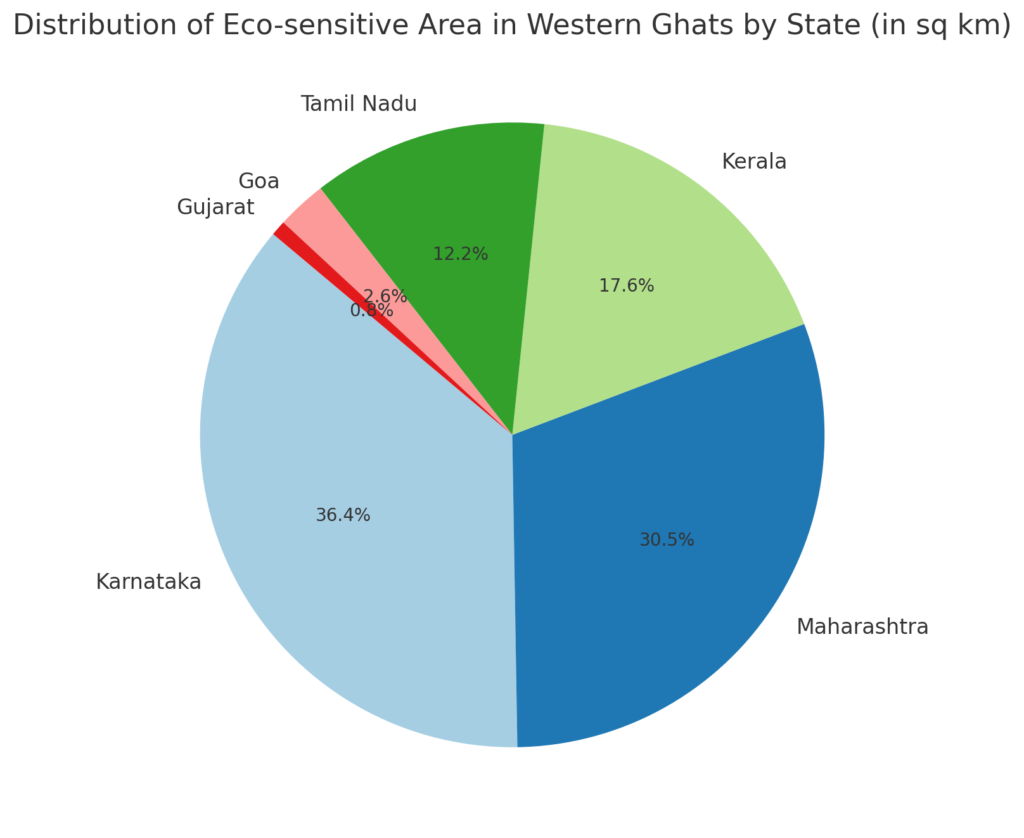Eco-Sensitive Areas in the Western Ghats
Context
The Union Government has issued the sixth draft notification to designate approximately 56,825.7 square kilometers of the Western Ghats across six states—Gujarat, Maharashtra, Goa, Karnataka, Kerala, and Tamil Nadu—as an Ecologically Sensitive Area (ESA). This designation is intended to protect the unique biodiversity of the Western Ghats through restrictions on certain activities like mining and large-scale construction.

Eco-Sensitive Areas in the Western Ghats
| State | Area in Eco-Sensitive Zones (sq km) | Description |
|---|---|---|
| Karnataka | 20,668 | Karnataka has the largest eco-sensitive area among the six states in the Western Ghats region, covering 20,668 square kilometers. This represents a significant portion of the Western Ghats, emphasizing the state’s role in biodiversity conservation. |
| Maharashtra | 17,340 | Maharashtra holds the second-largest eco-sensitive area, with 17,340 square kilometers. This includes regions rich in forest cover and biodiversity, important for both ecological stability and local livelihoods. |
| Kerala | 9,993 | Kerala has designated 9,993 square kilometers as eco-sensitive, reflecting its lush landscapes and dense biodiversity. The region supports various endemic species and is crucial for ecological balance. |
| Tamil Nadu | 6,914 | Tamil Nadu’s eco-sensitive area spans 6,914 square kilometers, covering essential forest ecosystems in the Western Ghats, which contribute to water security and climate regulation. |
| Goa | 1,461 | Goa has 1,461 square kilometers as part of its eco-sensitive areas. This includes regions that support tourism, biodiversity, and serve as vital ecological buffers. |
| Gujarat | 449 | Gujarat has the smallest eco-sensitive area in the Western Ghats, with 449 square kilometers. These areas play an important role in preserving the state’s limited but unique biodiversity. |
Objective of the ESA Notification
The primary goal of this notification is to safeguard the rich ecosystems of the Western Ghats by curtailing activities that could cause irreversible environmental damage. The designated states have been provided with a 60-day window to express their views or objections regarding the demarcation of specific villages as part of the ESA.
What are Eco-Sensitive Zones (ESZ) and Areas (ESA)?
- Eco-Sensitive Zones (ESZ): Established around Protected Areas (PAs), ESZs serve as buffer zones to create a protective shield around ecologically significant regions. The goal is to act as a “shock absorber” and further safeguard biodiversity and natural resources from external pressures.
- Eco-Sensitive Areas (ESA): These areas possess unique biological resources that require heightened protection and conservation measures. Many of these regions host rare and endangered species, critical habitats, and play crucial roles in ecosystem functioning. ESAs are notified based on recommendations from the State Governments and in accordance with the Environment (Protection) Act, 1986.
Eco-Sensitive Areas (ESAs) are regions designated for special environmental protection due to their unique ecological characteristics, biodiversity significance, and fragile ecosystems. These areas often host rare or endangered species, critical habitats, and play a vital role in maintaining ecological balance and providing ecosystem services. To protect these areas from further degradation, various activities such as mining, industrial operations, and large-scale constructions are regulated or prohibited, ensuring conservation and sustainable development. The designation of ESAs aims to create a buffer zone around natural sites, acting as “shock absorbers” to minimize the impact of human activity on sensitive ecosystems.
Importance of Declaring the Western Ghats as Eco-Sensitive Areas
1. Environmental Vulnerability
- Landslide Risk: The Western Ghats are the second-most landslide-prone region in India after the Himalayas. Human activities like mining, construction, and deforestation have exacerbated soil erosion, making hillsides more unstable.
- Biodiversity Hotspot: Recognized as one of the eight global “hottest hotspots” for biological diversity, the Western Ghats are home to over 30% of India’s plant, fish, herpetofauna, bird, and mammal species. Numerous species are endemic, such as the Nilgiri tahr and the lion-tailed macaque.
- Hydrological Significance: The region’s rivers are crucial water sources for nearly 245 million people in peninsular India. The Western Ghats play a vital role in water retention, watershed management, and climate regulation.
Herpetofauna?
Herpetofauna is a term that refers to the reptiles and amphibians that live in a specific area or ecosystem. Herpetofauna are cold-blooded animals that provide many ecological services. For example, frogs and toads act as biological control agents by eating crop pests.
2. Conservation Milestones
In 2012, UNESCO designated sections of the Western Ghats as a World Heritage Site due to their unique biodiversity and ecological significance. Several areas are also protected under various designations, such as national parks and wildlife sanctuaries, including Silent Valley National Park and Periyar Wildlife Sanctuary.
State Responses and Reactions
- Concerns Over Development: Some state governments, including Maharashtra and Goa, have sought reductions in the extent of the ESA to allow for developmental projects.
- Karnataka’s Objections: The Karnataka government has raised concerns about potential adverse effects on local livelihoods, particularly related to development restrictions in the ESA.
- Industrial Pressures: Industries, including the mining sector and tourism businesses, have pressured the government to reconsider the restrictions, arguing that stringent regulations could impact economic growth.
Major Reports on the Western Ghats
Gadgil Committee Report (2011)
- Broad Coverage: Recommended designating the entire Western Ghats as an ESA.
- Categorization: Proposed a three-tier system to classify regions based on ecological sensitivity, with restrictions tailored accordingly.
- Focus on Forest Rights: Emphasized sustainable livelihoods and the rights of local communities.
- Opposition: Faced strong resistance from state governments and industries due to perceived restrictions on development.
Kasturirangan Committee Report (2013)
- Selective Protection: Proposed declaring only 37% of the Western Ghats as an ESA.
- Balanced Development: Focused on regulating developmental activities in highly sensitive areas, while permitting more flexibility in less sensitive regions.
- Monitoring Mechanisms: Suggested strengthening existing frameworks for environmental clearances and establishing an advanced monitoring agency.
- Reception: Considered more pragmatic by state governments and industries but was criticized by some environmentalists for being too lenient.
Challenges and Proposed Restrictions
- Prohibited Activities: Mining, large-scale construction, and activities that could harm the region’s ecosystem.
- Regulated Activities: Development projects that must follow stringent guidelines to minimize ecological impact.
- Livelihood Concerns: Balancing conservation with the economic and social needs of communities residing in these areas.
Conclusion
The Western Ghats, characterized by their dense population and unique landscapes, cannot be treated as isolated wilderness zones. Policymakers must strike a fine balance between conservation and development, considering both the ecological importance and socio-economic needs of the region’s inhabitants. Sustainable development in the Western Ghats is essential to maintain its rich biodiversity while meeting the needs of local communities.






